Reindeer and elk, both members of the deer family, exhibit notable differences.
Reindeer, typically associated with Arctic regions, are smaller and can reach heights of about 4.9 ft at the shoulder. In contrast, elk, predominantly found in North America and parts of East Asia, can stand tall at 5 ft to 5.3 ft. Both male and female reindeer boast antlers, a feature unique to them, while only male elk typically have antlers.
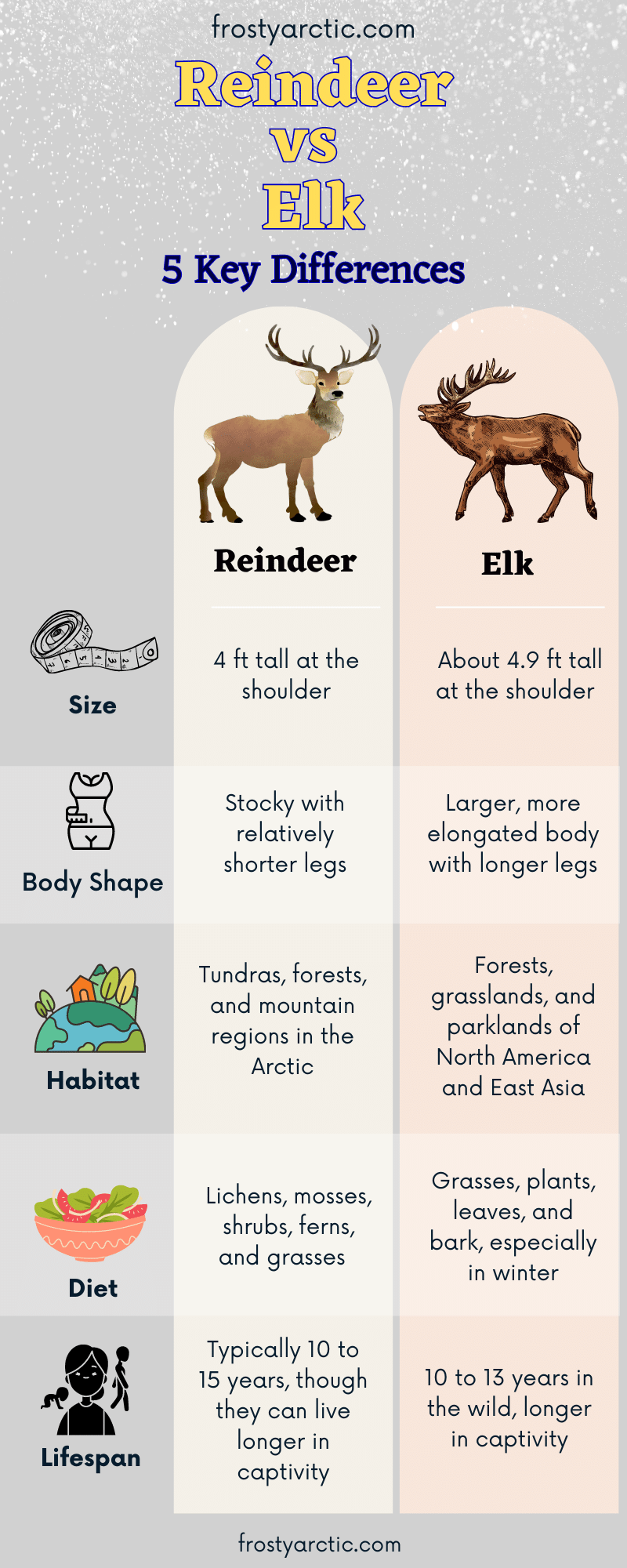
And speaking of behavior, did you know reindeer are renowned for their long migrations and tend to be more social, often found in larger herds? Elk, however, are less migratory, usually forming smaller groups or herds.
Intrigues yet? Dive deeper to explore the enthralling distinctions between the reindeer and the elk! Trust us; this journey is a trove of revelations you won’t want to miss!
Reindeer vs Elk – A Quick Comparison
| Feature | Reindeer | Elk |
| Scientific Name | Rangifer tarandus | Cervus canadensis |
| Body Shape | Stocky with relatively shorter legs | Larger, more elongated body with longer legs |
| Size | 4 ft tall at the shoulder | About 4.9 ft tall at the shoulder |
| Diet | Lichens, mosses, shrubs, ferns, and grasses | Grasses, plants, leaves, and bark, especially in winter |
| Habitat | Tundras, forests, and mountain regions in the Arctic | Forests, grasslands, and parklands of North America and East Asia |
| Social Behavior | Highly social, often found in larger migratory herds | Less migratory, usually form smaller groups or herds |
| Lifespan | Typically 10 to 15 years, though they can live longer in captivity | 10 to 13 years in the wild, longer in captivity |
| Gestation Period | Around 230 days | Roughly 240 to 262 days |
| IUCN Status | Vulnerable | Least Concern |
Reindeer vs Elk – What Are the Key Differences?
Reindeer and elk are both part of the same family and live in different parts of the Northern Hemisphere. They both have big antlers and are used to living in tough places with extreme weather. They mainly eat plants.
Even though they look somewhat similar, and some people might mix them up, they are actually quite different in many ways. Let’s dive deeper and learn more about these differences between reindeer and elk.
1. Taxonomy and Scientific Classification
Both reindeer and elk are iconic members of the deer family, Cervidae. However, they differ at the subfamily and genus levels.
Reindeer
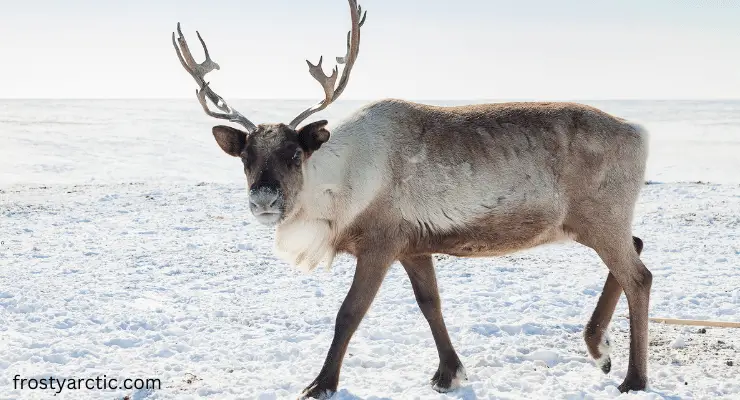
Reindeer, scientifically known as Rangifer tarandus, belong to the subfamily Capreolinae. They are cold-adapted deer recognized for their thick fur and majestic antlers, which both males and females exhibit.
Several subspecies of reindeer include:
- Barren-ground Reindeer (Rangifer tarandus granti)
- Tundra Reindeer (Rangifer tarandus sibiricus)
- Forest Reindeer (Rangifer tarandus fennicus)
- Mountain Reindeer (Rangifer tarandus tarandus)
- Woodland Caribou (Rangifer tarandus caribou)
- Peary Caribou (Rangifer tarandus pearyi)
- Greenland Caribou (Rangifer tarandus groenlandicus)
- Svalbard Reindeer (Rangifer tarandus platyrhynchus)
Elk
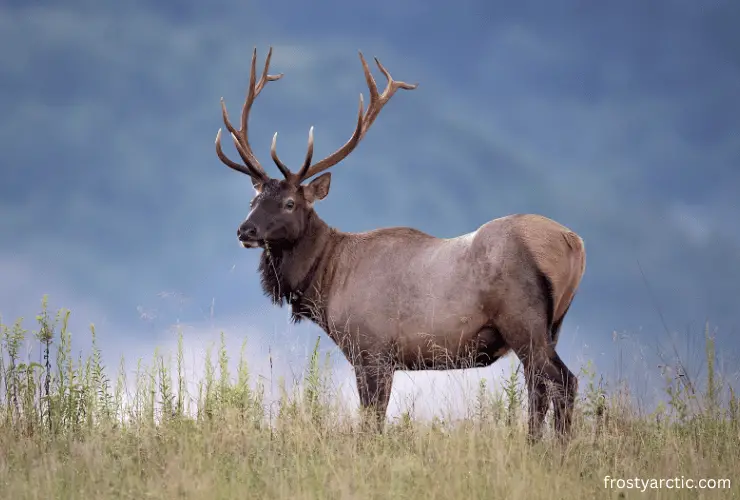
Elk is another member of the deer family, known scientifically as Cervus Canadensis. It belongs to the sub-family Cervinae. It is known as ‘wapiti’ by Native American tribes, which means “light-colored deer.” In Europe, interestingly, “elk” refers to what North Americans call “moose.”
Notable subspecies of elk include:
- Rocky Mountain Elk (Cervus canadensis nelsoni)
- Roosevelt’s Elk (Cervus canadensis roosevelti)
- Tule Elk (Cervus canadensis nannodes)
- Manitoban Elk (Cervus canadensis manitobensis)
- Alashan Wapiti (Cervus canadensis alashanicus)
- Altai Wapiti (Cervus canadensis sibiricus)
| Taxonomic Level | Reindeer | Elk |
| Kingdom | Animalia | Animalia |
| Phylum | Chordata | Chordata |
| Class | Mammalia | Mammalia |
| Order | Artiodactyla | Artiodactyla |
| Family | Cervidae | Cervidae |
| Subfamily | Capreolinae | Cervinae |
| Genus | Rangifer | Cervus |
| Species | R. tarandus | C. canadensis |
2. Habitat and Distribution
Both have adapted to unique environments and are distributed across distinct geographies.
Reindeer
Reindeer are specially adapted to cold environments. Their habitat spreads across the Arctic and subarctic tundra, forests, and mountainous regions of the northern parts of the Northern Hemisphere.
Some subspecies, like the woodland caribou, prefer the expansive boreal forests, or taigas, stretching from Alaska through Canada.
Meanwhile, mountain reindeer prefer the alpine regions. They are typically found in parts of Scandinavia, as described in an article published in Landscape Research.
Elk
Elk, by contrast, are animals of diverse terrains. They inhabit a variety of environments ranging from dense forests to open plains.
Mostly at home in forested areas, they utilize adjacent meadows and clearings. They’re commonly found in the forests of the Rocky Mountains. Yet, some choose the grasslands, like those in parts of Montana and the Dakotas.
The Roosevelt’s elk is a unique bunch, preferring the rainforests of the Pacific Northwest. While North America is their primary home, a few have ventured (or been introduced) beyond, with some making a new home in places like New Zealand. ~Source
| Distribution | Reindeer | Elk |
| Primary Habitats | Tundras, Forests, Mountains | Forests, Grasslands, Coastal Rainforests |
| Native Continents | North America, Europe, Asia | North America |
| Domestication | Yes, in Northern Europe and Siberia | Rarely, mostly wild |
| Regions | Arctic and subarctic regions, Scandinavia, Russia, Canada, Alaska | Mainly Western North America, from the Rockies to the Pacific, introduced populations in New Zealand |
3. Physical Appearance
Both elk and reindeer are prominent members of the deer family, but their physical attributes can be pretty unique.
Reindeer
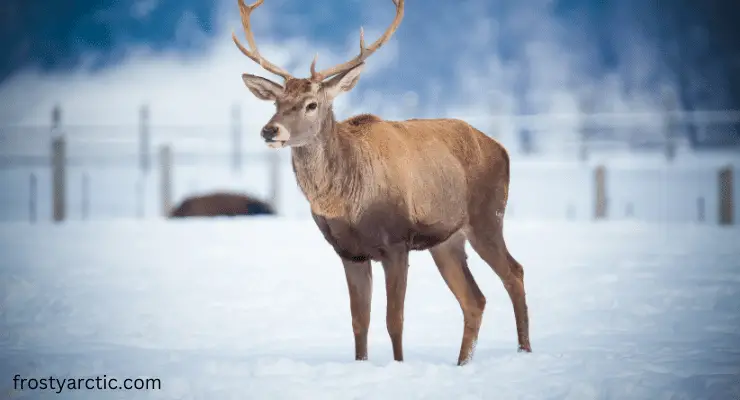
- Size: Reindeer are medium-sized, with males usually reaching 4 feet tall and weighing 550 pounds. Females are slightly smaller.
- Antlers: Both male and female reindeer grow antlers. The antlers are broad and flat, often with multiple tines, and can be quite elaborate. Females use them primarily for foraging beneath the snow.
- Fur: Reindeer have a thick, dense coat that can vary in color from white to brown. This fur is adapted to the chilly regions they inhabit, offering insulation.
- Nose: Their nose is particularly adapted to heat the air they breathe before it reaches the lungs.
- Hooves: Reindeer have large, crescent-shaped, splayed hooves that are useful for moving in snow and soft tundra. They act like snowshoes!
Elk
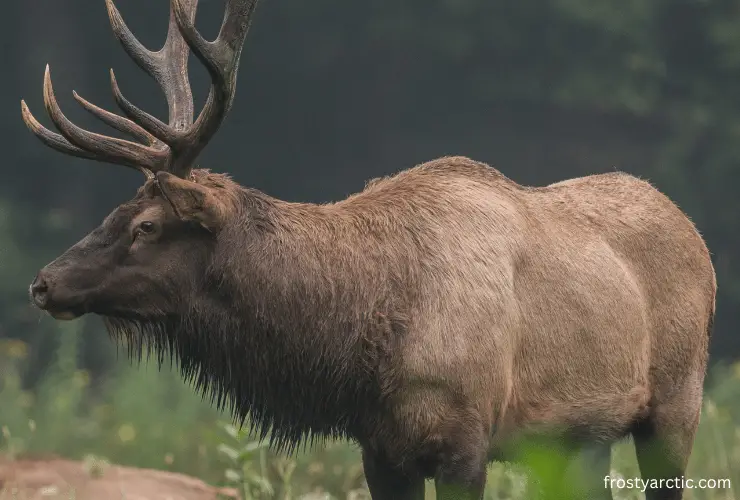
- Size: Elk are one of the biggest species within the deer family. Bulls can be up to 5 feet tall, and weigh around 700 to 1,100 lbs. Whereas females, or cows, typically weigh 500 to 600 pounds and are up to 4.5 feet tall.
- Antlers: Only males have antlers, which they shed annually. These antlers can be massive, with some reaching lengths of four feet. They are more elongated and branch-like compared to the reindeer.
- Fur: Elk have a dense coat that is typically a light brown, with darker brown or even black shadings on the head, neck, and legs. Their rump patch is notably lighter, almost creamy white.
- Mane: Bulls often have a prominent mane, which is thicker and darker than the rest of their fur.
- Muzzle: Their snout is slender and elongated, distinct from the reindeer’s more compact nose. ~Source
| Feature | Reindeer | Elk |
| Size | 4 ft tall at the shoulder, 550 lbs | 5 ft at the shoulder, up to 1,100 lbs |
| Antlers | Both sexes; broad, flat, with many tines | Males only; long, branching |
| Fur Color | Ranges from white to brown | Light brown with darker and lighter shadings |
| Special Features | Adapted nose, large splayed hooves | Prominent mane in bulls, elongated snout |
4. Diet and Feeding Habits
Reindeer and elk have unique diets and feeding habits reflecting their adaptation to distinct environments.
Reindeer
- Lichens: During winter, reindeer’s primary food source is lichen, especially a type known as “reindeer moss” (which isn’t really moss but a lichen). Their digestive system contains specialized bacteria that help break down lichen, which many other herbivores can not digest.
- Shrubs & Grasses: In the summer, they switch to a varied diet, consuming various plants, including grasses, sedges, and shrubs.
- Fungi: Reindeer are also known to consume fungi, particularly during autumn.
- Others: They also feed on lemmings, fish, and bird eggs, but their diet mostly includes plant matter.
Reindeer utilize their specially adapted hooves to dig through the snow to reach their food.
Elk

- Grasses: During the warmer months, elk mainly graze on grasses.
- Woody Plants: In the winter, they switch to woody plants, including the branches, twigs, and bark of trees and shrubs.
- Forbs: During spring and early summer, elk also feed on forbs, which are flowering plants other than grasses.
They migrate to areas with more nutritious food, particularly during calving season. This ensures the best nutrition for the young. ~Montana State University
| Feature | Reindeer | Elk |
| Primary Winter Food | Lichens | Woody plants (branches, twigs, bark) |
| Primary Summer Food | Grasses, sedges, shrubs | Grasses, forbs |
| Special Dietary Adaptation | Digestive bacteria for lichen digestion | Migrate for better nutrition during calving season |
| Other Foods | Fungi | Occasional fruits and nuts |
5. Social Behavior
Both animals have their own social structures, habits, and behaviors crucial for their survival and breeding.
Reindeer
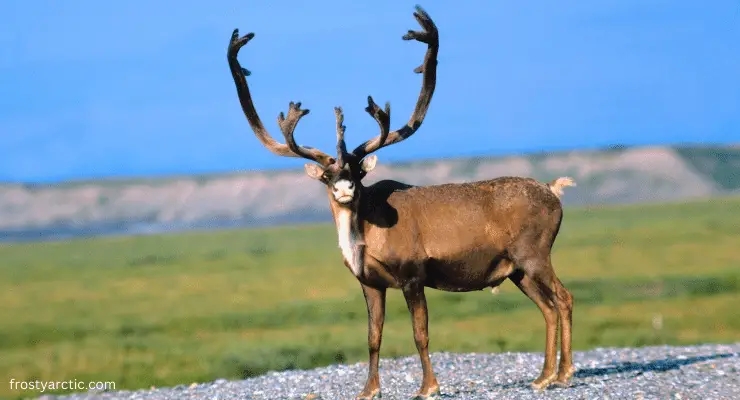
- Herd Life: Reindeer are highly gregarious animals, often found in large herds, especially during migrations. These herds can number in the thousands!
- Migrations: Their epic migrations are a central part of their life. These journeys are about finding food and avoiding predators, and the safety of numbers is vital.
- Maternal Bonds: Female reindeer form close-knit groups, often accompanied by their calves. ~Source
Elk
- Seasonal Herds: Elk often form herds, but these groupings are typically more pronounced during different seasons. For instance, females and their calves might form large groups during the summer, while males might form smaller bachelor groups.
- Rutting Season: Male elk become highly territorial during the mating season, known as the rut. They use their impressive antlers to spar with rivals. Their bugling calls echo across the valleys to attract females and challenge other males.
- Maternal Care: Female elk are protective mothers. They often isolate themselves to give birth and hide their calves for the first week, visiting them only to nurse.
- Migration: Similar to reindeer, some elk populations migrate, especially to reach areas with more abundant food during different seasons. ~Source
| Feature | Reindeer | Elk |
| Herd Structure | Large herds, especially during migrations | Seasonal herds; separate male and female groupings |
| Mating Behavior | Males compete for females, but less aggressive than elk | Rutting season with territorial males and bugling |
| Mother-Offspring Bonding | Strong maternal bonds with calves | Protective mothers; hide calves after birth |
| Human Interaction | Domesticated by some communities | Mostly wild; some introduced populations might be habituated to humans |
6. Reproduction and Lifecycle
The reproductive cycles and lifecycles of reindeer and elk also differ.
Reindeer
- Mating Season: The mating season for reindeer usually occurs during the fall, typically in late September and October.
- Competition: While male reindeer do compete for access to females, their confrontations are typically less violent than those of elk, as detailed in Animal Reproduction Science.
- Gestation and Birth: After mating, female reindeer have a gestation period of about 230 days, leading to calving in late May or early June.
- Calves: Newborn calves can stand within a few hours of birth, a vital adaptation to avoid predators. They are usually weaned by September.
- Lifespan: On average, wild reindeer live up to 10-15 years, though some domesticated ones can live longer.
Elk
- Mating Season: The rut for elk occurs in the fall, roughly between September and October.
- Competition: Male elk compete fiercely for mating rights. They engage in intense battles using their large antlers and produce haunting bugles, which serve to attract females and challenge rival males.
- Gestation and Birth: After successful mating, elk cows have a gestation period of about 240-262 days. Calves are usually born in May or June.
- Calves: Elk calves can stand soon after birth. They sport a spotted coat for camouflage against predators.
- Lifespan: Elk typically live 10 to 13 years in the wild. However, in areas with fewer natural predators or captivity, they might live up to 20 years. ~Forest Service
| Feature | Reindeer | Elk |
| Mating Season | Fall (late September – October) | Fall (September – October) |
| Gestation Period | ~230 days | 240-262 days |
| Calving Time | Late May – early June | Late May – early June |
| Young’s Adaptation | Stand within hours, weaned by September | Stand shortly after birth, spotted coat for camouflage |
| Average Lifespan | 10-15 years (longer if domesticated) | 10-13 years (up to 20 in some conditions) |
7. Natural Predators
Despite their impressive sizes both reindeer and elk have natural predators that influence their behavior, migrations, and lifecycles.
Reindeer
The gray wolf is a primary predator of reindeer. Wolves hunt in packs and can take down adult reindeer, though they often target the young or weak.
Brown bears, Mountain lions, Arctic foxes, and Coyotes also pose a threat to reindeer, particularly to young calves.
Surprisingly, golden eagles also hunt reindeer calves during their first few weeks of life.
Elk
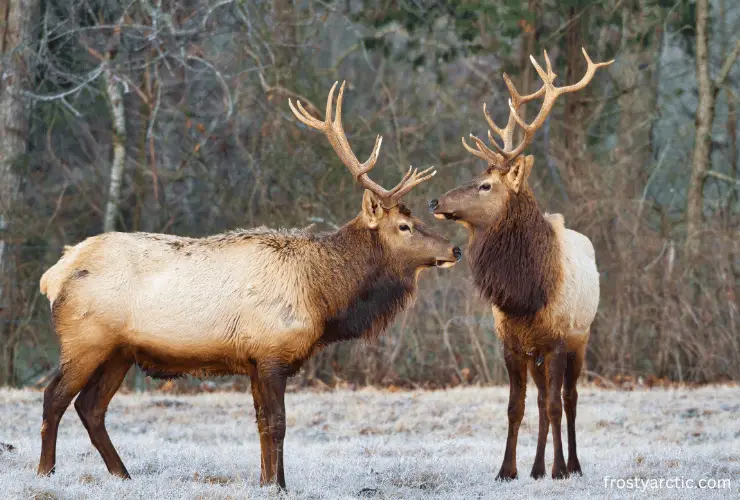
Like reindeer, wolves are a significant predator of elk, especially in areas like Yellowstone National Park. They often target calves or older individuals.
Other predators, such as grizzlies, black bears, and mountain lions, often aim for young elk or weakened adults. Bobcats and coyotes also opportunistically hunt elk calves. ~University of Michigan
| Species | Natural Predators |
| Reindeer | Wolves, Polar bears, brown bears, Golden eagles (to calves) |
| Elk | Wolves, Mountain Lions, Grizzlies, black bears, bobcats, and Coyotes (primarily for calves) |
8. Defense Mechanism
Both reindeer and elk have evolved unique ways to protect themselves from potential threats.
Reindeer
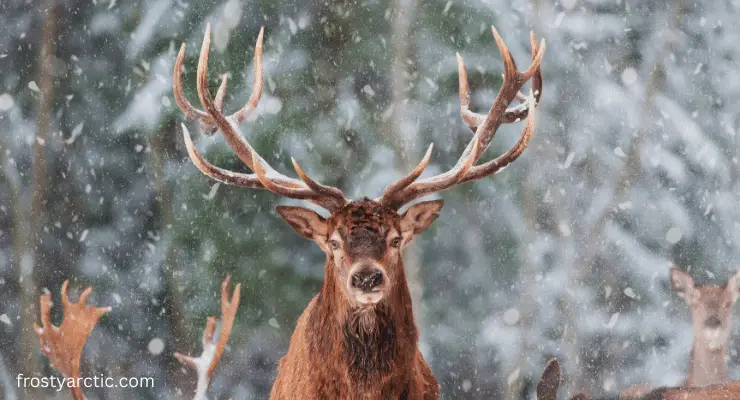
- Antlers: Both males and females grow antlers, a feature unique in the deer family. These antlers can serve as formidable weapons against potential threats.
- Group Defense: Reindeer often form large herds, especially during migrations. There is safety in numbers, and a large group can deter predators.
- Speed & Stamina: Reindeer have powerful legs, capable of reaching speeds up to 50 mph in short bursts. This speed is crucial in evading faster predators like wolves.
- Camouflage: Their fur, which changes color with the seasons, helps them blend into their surroundings, especially during winter.
Elk
- Antlers: Male elk grow large and impressive antlers, which are used during the rutting season to battle rivals and can also serve as a defense against predators.
- Hooves: Strong and sharp, elk hooves can deliver powerful kicks, especially when the animal feels cornered.
- Speed: Like reindeer, elk can run at impressive speeds, capable of reaching speeds up to 45 mph in short bursts, making it difficult for many predators to catch them.
- Herding & Vigilance: Female elk and their young often stay in groups. The many eyes of the herd increase the chances of spotting a lurking predator.
| Feature | Reindeer | Elk |
| Antlers | Both sexes have antlers, useful for defense. | Most males have large antlers for defense and competition. |
| Speed | 50 mph | 45 mph |
| Group Behavior | Large migrating herds | Female herds and young groupings |
| Camouflage | Seasonally changing fur color | Not as pronounced as reindeer but adaptive to surroundings |
| Vocalizations | Less pronounced in warding off predators | Bugling during the rut can deter some predators |
9. Interaction With Humans
Both reindeer and elk have coexisted with humans for millennia. The way each species interacts with humans has been shaped by history, geography, and cultural practices.
Reindeer
Reindeer have been intertwined with human societies, particularly in the colder regions of the world.
- Domestication: One of the few large mammals to be domesticated by humans, reindeer have been herded by the indigenous Arctic and sub-Arctic peoples, like the Sami in Scandinavia and the Nenets in Russia, for thousands of years.
- Livelihood: These terrestrial animals are not just sources of transportation but also provide meat, milk, hides, and antlers which are used for tools, clothing, and shelter by indigenous communities.
- Cultural Significance: In certain cultures, reindeer have spiritual and symbolic importance. The most famous cultural representation worldwide is their association with Santa Claus and his sleigh during Christmas.
Elk
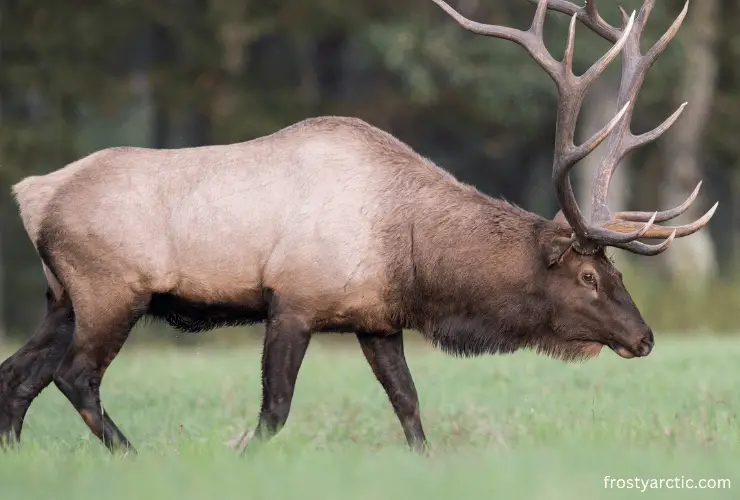
Elk, on the other hand, has a different history of human interaction.
- Hunting: Historically, indigenous tribes in North America relied on elk for sustenance, tools, and clothing. Modern sport hunting of elk is also popular in many parts of the U.S.
- Elk Farms: In some regions, elk are raised on farms for meat, velvet from their antlers, and other commercial purposes.
- Cultural Significance: Elk holds cultural and spiritual significance for many indigenous tribes. They’re symbols of strength, agility, freedom, and the wilderness.
| Feature | Reindeer | Elk |
| Domestication | Widely domesticated in the Arctic and sub-Arctic regions. | Mostly wild, but some are farmed |
| Use by Humans | Meat, milk, hides, transportation, antlers | Meat, hides, antlers, and in some places, elk velvet |
| Cultural Significance | Integral to many Arctic cultures, Santa’s sleigh | Significant to indigenous tribes; a symbol of the wilderness |
| Recreational Interaction | Limited to some tourism in the Arctic regions | Sport hunting and wildlife viewing in natural parks |
10. Threats and Conservation Status
Both reindeer and elk, like many wildlife species, face many challenges in the modern world.
Reindeer
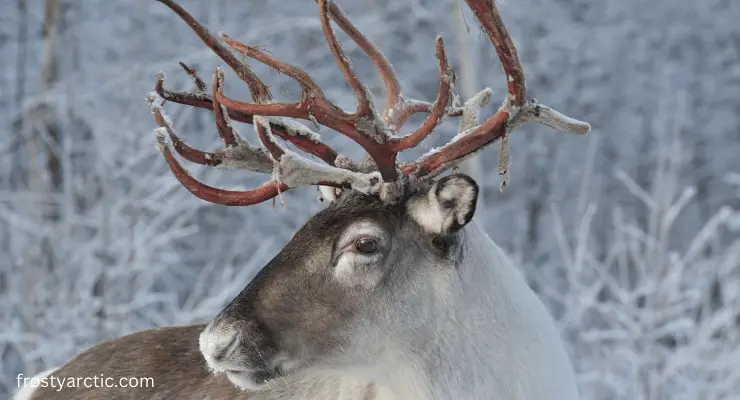
Reindeer are well-adapted to their Arctic and sub-Arctic homes. Still, they are not immune to the rapid changes happening in their environments, as detailed by the World Wildlife Fund. Their populations declined due to:
- Climate Change
- Oil, gas, and mining developments
- Overharvesting.
As reported by the IUCN Red List, the conservation status of reindeer is “Vulnerable”..
Elk
Elk, once roaming vast stretches of North America and parts of East Asia, have seen their territories shrink and populations fluctuate. Their populations are at risk of:
- Habitat Loss
- Overhunting
- Diseases like Chronic Wasting Disease (CWD)
Many elk populations have rebounded due to dedicated conservation and reintroduction efforts. They’re typically classified as “Least Concern” by the IUCN, but localized populations may face more significant threats.
| Feature | Reindeer | Elk |
| Major Threats | Climate change, industrial development, overharvesting | Habitat loss, historic overhunting, disease |
| Conservation Status | Ranges from “Vulnerable” to “Least Concern” | Generally, “Least Concern,” but some local populations at risk |
Wrapping Up
So, are Reindeer and Elk the same? Definitely not! While both are members of the deer family, they’ve distinct features and habitats.
Adapted to Arctic climates, Reindeer are recognized for their migrations and friendly nature. Both male and female reindeer have antlers. Conversely, Elk are larger and predominantly reside in North America and parts of Asia. Only male elk showcase those magnificent antlers. Their behaviors, size, and even the regions they inhabit set them apart.
We hope this article has helped you differentiate between the two deer species. Next time you spot one of these animals, you will have a clearer idea of who’s who in the deer world!


